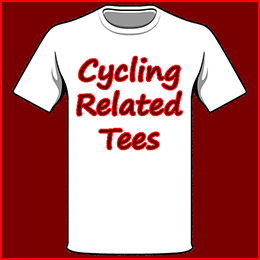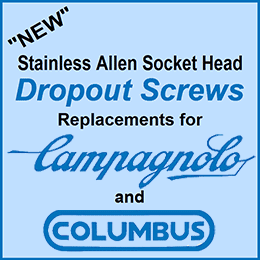Vent Holes
 Mon, June 22, 2020
Mon, June 22, 2020  I am sometimes asked, why are there tiny holes drilled in certain parts of a bicycle frame, like the ones shown on the left?
I am sometimes asked, why are there tiny holes drilled in certain parts of a bicycle frame, like the ones shown on the left?
These are vent holes. During the brazing process the air inside the tube expands as it is heated. The vent hole allows the air to escape as it warms up and allows for air to enter as it cools.
If the tube is totally enclosed, on cooling the air contracts sucking the molten brass inside the tube leaving a pin hole that is almost impossible to fill.
Worse still pressure can build up in an un-vented tube and hot brass can blow back in your face. Anyone not knowing this will soon learn the importance of vent holes after picking little globules of brass embedded in their face or finds little brass balls hanging like tiny Christmas Tree decorations from eyebrows, mustache, or other facial hair
Vent holes are only needed when a tube is closed both ends like the example shown above. The top tube is closed at both ends and is usually vented with holes into the seat tube and head tube. (When the bike is assembled these holes are hidden.)
Seatstays are enclosed with a fork dropout one end and the seatstay cap at the top. The front fork blades are also enclosed both ends between the fork crown and the fork tip or dropout.
Other tubes like the seat tube, down tube and the chainstays are open inside the bottom bracket shell. These tubes are not totally enclosed so do not need any additional vent holes; neither does the brake bridge because it has a brake bolt hole.
On some of my custom frames you won't see holes in the chainstay bridge like the one in the picture. They are hidden inside the bridge tube by drilling holes sideways through the left and right chainstay tube, before the bridge tube was put into place. Only one hole is needed for venting but often two holes are drilled for better drainage of moisture later.
The vent hole in the seatstays on my frames is on the inside up near the seat lug. You might have to turn the bike upside down to see it.
On my front fork blades I drilled one vent hole in each fork blade near the bottom, but after the fork was fully brazed and had cooled I went back and filled it by brazing a piece of wire in the hole. The heat generated in doing this was so small and the air space inside the fork blade was big enough that it did not cause a problem. This whole process only took a minute to complete.
I did this for two reasons. Front fork blades are highly stressed, so filling the hole eliminated a potential weakness at that point. Also rust needs oxygen, and with the fork blades completely enclosed and airtight, no corrosion inside is possible, even years down the road.
A small and probably unnecessary precaution, but one that took such a small amount of time, I always figured, why not?




























Selling the Benefit
In other words, “How will the consumer’s life be made better” if he buys whatever it is you are selling. In the case of a bicycle, how will it improve his performance?
One can build or manufacture just about anything then put up some wonderful sounding argument stating why it is of benefit to the user. Most of these statements cannot be proved or disproved.
Even when these theories are disproved, nobody really cares least of all the company who has made a lot of money, and everyone just moves on to whatever the next trend is.
In the late 1960s Cinelli built a frame that was absolutely devoid of all brazed-on fittings, stating that braze-ons weakened the frame. Gear levers, cable guides, etc. all had to be clamped on to the frame. (Picture top left.)
Some years later people realized that the clamps held moisture and started rust spots, and the clamps sometimes caused stress risers and tubes often broke adjacent to the clamp.
For a while every other framebuilder followed suit, because it saved a tremendous amount of time. (Which was of course the real reason.) Cinelli had stumbled on an incredibly simple way to cut labor costs, then actually sold the idea to the consumer as a benefit.
At the time Cinelli charged double what anyone else did for a frame. The psychology was, it costs more, and therefore it must be better. Also, if it costs more you win the one-upmanship game. A psychology that is still being played out in today’s high-end bicycle market.
Weight saving is always an easy sale to the bicycle enthusiast. Push weight saving to its limits and in the case of a frame, it becomes flexible. Then you sell the idea that a flexible frame is an actual benefit to the rider. The big question here is, “How much flex?” Aluminum for example makes a very strong and lightweight frame. However, it has little or no flexing qualities.
Back when I built frames, they were made by brazing a high tensile steel tube into a lugged joint. In the case of Columbus, the tubes were heat treated and were like a very strong steel spring. When the framebuilder heated the tubes to braze the joint it actually softened the tubes, thereby losing a tiny amount of the strength, and spring qualities.
Remember Cinelli’s argument that braze-ons weakened the frame. Actually there was a grain of truth in that statement. However, brazing the lugged joint and attaching braze-ons is part of the frame building process. The tubes are actually designed to withstand losing some of the strength during the building process. Brazed correctly, the end product is still far stronger than it need be.
This is why steel tubes are butted, (Greater wall thickness at each end.) so there is still adequate strength left after the joint is made. The trick is to use just enough heat to get the job done, but not heating the tube a greater distance from the lug or braze-on than necessary, thus retaining as much of the tube’s inherent strength as possible.
Because a frame is like a very stiff steel spring, when the rider makes a sudden effort as when he jumps in a sprint, the frame gives or flexes slightly. This is desirable, but the operative word here is “Slightly." It is like the difference between an athlete jumping from a concrete track or floor, and one jumping from a Tartan track surface or a floor made from wooden boards.
There is an old Briticism, (A saying from the UK.) that “Bull shit baffles brains.” So whenever you are reading the sales pitch for the latest and greatest high tech wonder. (Not just bicycles, but any consumer product.) Keep an open mind.
They are selling the benefit. Your life will somehow be better for owning this product. Turn that idea around and ask, “What is the benefit to the manufacturer?” Is this product really better than the old one, or has the manufacturer found a cheaper way to make it?
Or has the manufacturer simply come up with something "New and Improved," that serves no real purpose other than to make the old one obsolete.